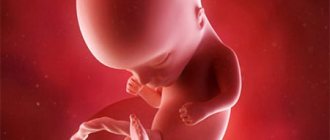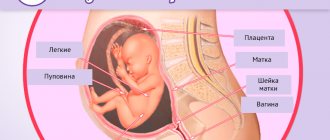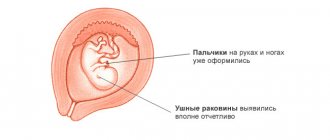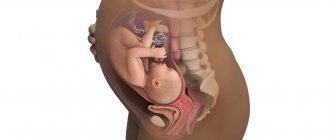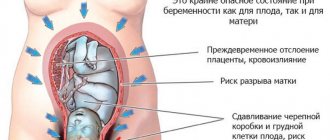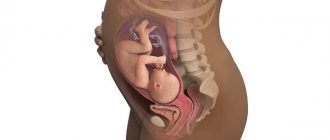Why do disagreements arise in terms?
It is very difficult to accurately determine the day of conception. This can only be done if the woman remembers the date of unprotected sexual intercourse, carefully monitors her basal temperature and has a regular menstrual cycle.
Doctors use the obstetric term to calculate pregnancy. This is a method based on calculating pregnancy from the first day of the last menstrual period. If you start the calculation directly from conception, then this period of calculation is called embryonic.
The difference between obstetric and embryonic periods is usually 10-14 days. Pregnancy lasts 40 obstetric and 38 embryonic weeks.
What happens in the body
If we talk about the obstetric two weeks of pregnancy, then there can be no talk of any signs and symptoms in a woman. After all, this period is characterized only by the preparation of the body for fertilization.
When we talk about the 2nd week of the embryonic period, it is quite possible to talk about certain sensations in the expectant mother. Many girls complain that their lower abdomen is tight and they feel discomfort in the lumbar region. Less common are signs such as swelling and increased sensitivity of the breast, toxicosis. Of course, taking into account the symptoms in the form of nagging pain and changes in the mammary glands, it should be noted that these manifestations may well indicate the beginning of menstruation.
Fetus
There are no sufficient grounds yet to talk about a fetus at the 2nd week of pregnancy: at this stage, only its appearance is allowed if fertilization is successful. The fetus in the second week of pregnancy exists only in the form of an egg placed in the follicle, which is its container. The egg, being the largest cell in the human body, will “set off” on a journey and search for a “suitable” sperm as soon as the follicle ruptures, and this phenomenon is precisely called ovulation. When an egg is fertilized, containing half of a woman's chromosome set in the amount of 23 chromosomes (the second - the male half - is added during fertilization), and when it is implanted into the uterus, we can already talk about pregnancy, that from now on the fetus will develop and gradually grow.
Miscarriage
If fertilization does not occur, the woman will have a miscarriage at 2 weeks of pregnancy. Again, there is no need to talk about a full-fledged miscarriage; rather, we are talking about an unsuccessful attempt to get pregnant. There may be plenty of reasons for this, and the doctor will help eliminate any obstacles to successful fertilization next time after appropriate consultation and a full examination.
Feelings 2 weeks after a missed period
During this period, the girl may well feel her delicate position in many ways. Some representatives of the fair half are already aware of the impending conception. Most mothers clearly begin to feel the signs of 2 weeks of pregnancy. These include:
- headaches and dizziness;
- general weakness, malaise;
- change in emotional background, the appearance of tearfulness, anxiety;
- increased breast sensitivity, swelling of the mammary glands;
- often women complain that their lower abdomen hurts and pulls;
- nasal congestion;
- change in taste preferences;
- nausea, vomiting.
All these signs may be completely absent. It all depends on the individual characteristics of the body. Many mothers do not experience toxicosis until the day of birth.
You might be interested in: How to tell if you're pregnant at home
How the uterus changes
The woman does not feel any new signs from the reproductive organ. Throughout its life, the egg has moved through the fallopian tubes more than once, so this process is considered quite familiar to the body.
The first significant changes will occur at a later date (4-6 weeks). When the embryo begins to actively develop in the uterus, a woman may feel a pulling sensation, which is explained by contraction of the organ.
Only minor nagging pain in the lower abdomen and lower back should not cause concern. If the pain is severe, you should immediately visit a doctor.
What can be seen on an ultrasound
At 2 weeks after conception, that is, at the 6th obstetric week, the ultrasound machine will be able to fully visualize the embryo. If your pregnancy is only 2 weeks according to the obstetric term, the doctor will most likely advise you to postpone the ultrasound examination, because it will be uninformative and the embryo will not be visible.
At 2 weeks after conception, an ultrasound will show a tiny dot in the uterine cavity, which is your baby. Moreover, the small organism weighs less than a gram, and its height is less than a millimeter.
Despite the fact that the size of the embryo is still very tiny, it develops very actively. Cells divide, which provides the basis for the appearance and development of all internal organs.
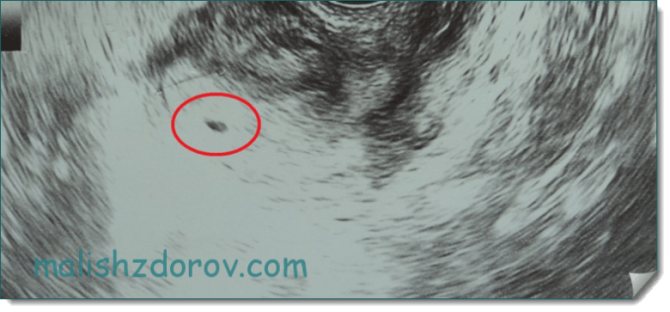
In this photo you can see what the embryo looks like on an ultrasound scan at 2 weeks after conception or at the embryonic stage.
Ultrasound
An ultrasound is usually not required at the 2nd week of pregnancy - unless it is necessary to assess the readiness of the endometrium for conception. An ultrasound examination allows you to see the dominant follicle, but it is still almost impossible to see the egg, it is still too small. An ultrasound at 2 weeks of pregnancy may be indicated for women planning a pregnancy who have had problems conceiving in the past. So, in rare cases, it happens that the follicle does not contain an egg, and then fertilization will not occur. Although in most cases this situation is an exception rather than a pattern.
Development of the embryo at this stage
What happens in the 2nd week of pregnancy from conception? At this stage, the embryo is located in the Graafian vesicle. Surprisingly, already at this stage some extra-embryonic organs have been formed. These include the yolk sac, chorion and amnion. They help the tiny body get everything it needs for further growth and development.
At the end of the period under consideration, the embryo is already a mature egg with a nucleus and cytoplasm enclosed in a thin transparent membrane. The size of the embryo is now impossible to measure, as is the weight of the unborn child. In the third week of pregnancy, the diameter of the embryo is approximately 0.15 millimeters. The tiny organism reaches a weight of one gram only at the end of the second month.
What does your baby look like at 2 weeks pregnant?
Your unborn baby is as tiny as a microscopic chicken egg. The amniotic fluid is comparable to the albumen (egg white), and the embryo is comparable to the egg yolk (the unborn child).
The main purpose of amniotic fluid is to nourish the developing baby until the placenta is fully formed and ready to give the baby all the nutrients.
The belly of the expectant mother in the second week of pregnancy is still completely invisible, but the new life of the little man is already actively beginning to develop in it.
What can a woman’s discharge indicate?
When conception occurs, women often notice a change in the nature of vaginal discharge. Depending on their nature, the doctor can determine normality or pathology.
Mucous
Such a sign as an increase in the amount of cervical mucus, released in a certain amount by each woman, is a completely normal phenomenon during pregnancy. The mucus should be clear and odorless. Outwardly, it resembles egg white. This symptom indicates that hormonal changes have begun in the body and the woman is preparing to bear a fetus.
Curdled white
Sometimes, at the initial stage of the delicate period, girls develop thrush. A cheesy discharge with an unpleasant odor is accompanied by itching, burning and some other symptoms. The cause of thrush is a decrease in immunity, because this is necessary so that the fetus is not rejected by the uterus. Treatment of thrush should be carried out according to the recommendations of a doctor.
Slight bloody or brown
Few people know about implantation bleeding. Representatives of the fair half are accustomed to believing that during pregnancy menstruation does not occur and any bleeding is a pathology. This is not entirely true. The fact is that during the attachment of the embryo to the wall of the uterus, slight bloody or brownish discharge may appear. Do not be alarmed when you discover this sign; such a symptom is quite normal.
You might be interested in: Serozometra - ICD-10 code
Bleeding
Many people know about the danger of bleeding. It is very important to be able to distinguish this symptom from menstruation. When bleeding, the blood usually has a scarlet character, and not brown, as during menstruation. If a woman suspects pregnancy, but after some time she starts bleeding, this may be a sign of a miscarriage. In such a situation, you should immediately go to the hospital.

Bleeding is one of the very dangerous symptoms that often indicates a miscarriage.
Methods that predict ovulation:
There are quite a few ways to help predict your ovulation. If you look for signs of ovulation, you can thus predict your fertile window, which will help you determine when you might be able to conceive.
Track your cycle:
A typical menstrual cycle lasts 28 days. Some women have different cycle lengths, and their cycles may vary from month to month.
Track your menstrual cycle for at least six months so that you know the actual pattern of your cycle. This will help you calculate your ovulation time based on your average menstrual cycle.
You can also use an ovulation calculator
Basal body temperature:
During ovulation, your basal body temperature changes. There is a chance that you will become pregnant 2 - 3 days before your temperature rises. You can take and record your temperature at around the same time every day.
MORE INTERESTING TO READ: Early signs of pregnancy with a boy
You should take your temperature when you get up in the morning. By recording every day, you will understand the difference, and accordingly, you can try to conceive before the temperature rises.
Vaginal discharge:
When you ovulate, your vaginal discharge changes in consistency and texture. They become slippery and transparent. After ovulation, the consistency of the discharge becomes thicker and becomes lighter in color, and then fades away.
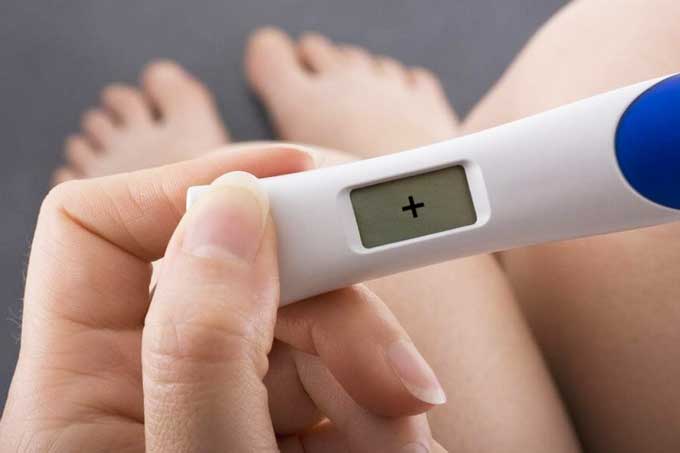
Ovulation test:
Another way to determine ovulation is through an ovulation test. These test kits use a sample of your urine to detect hormones that can predict ovulation. You must follow the instructions to get accurate results.
The earliest signs of pregnancy
How does a woman feel at 2 weeks pregnant? It’s too early to talk about signs in the second obstetric week, but if we are talking about the second week after conception, many symptoms can be described here.
Basal temperature
As already mentioned, only those women who have a regular menstrual cycle can use this diagnostic method. Basal temperature (BT) changes throughout the month, depending on hormonal fluctuations.
The menstrual cycle is divided into 2 phases (before and after ovulation). In the first phase, BT, as a rule, stays within 37 degrees Celsius. Before ovulation, BT reaches minimum levels, and after ovulation it increases.
If 10-14 days after the jump in this temperature it does not decrease, but remains elevated, this sign indicates an increase in the level of the hormone progesterone, that is, the onset of conception.
Nagging pain in the lower abdomen
After moving along the fallopian tube, the fertilized egg is implanted into the endometrium of the uterus. During this period, observant girls may feel a pulling or painful sensation in the stomach. In addition, slight spotting may be observed, which also indicates the attachment of the embryo. These signs are quite normal and should not cause concern.
Change in general condition
Due to hormonal changes, many mothers experience the following changes:
- the appearance of tearfulness, sentimentality;
- deterioration of mood and general well-being;
- increased secretion of cervical mucus;
- slight increase in body temperature;
- nausea, weakness.
All of these signs are normal. This is how an increase in the level of the hormone progesterone in the body manifests itself.

During this period, women are advised to rest more and reduce physical activity.
Change of taste preferences
Our ancestors began to suspect pregnancy based on this common sign. Hence the expression “craved something salty.” Many mothers, unaware of their delicate situation, may not notice this. The change in taste preferences becomes more pronounced with the further development of pregnancy.
Changes in the breast
At 2 weeks after conception, a woman may already notice some changes in the mammary glands. These include the following signs:
- darkening of the areolas;
- increased nipple sensitivity;
- breast enlargement;
- soreness;
- swelling of the mammary glands;
- strengthening of the vascular network.
At this stage, the girl should already think about choosing a comfortable bra made from natural materials. You should worry about breast health already at the first stage, because breast milk is vital for the baby after birth.
Lack of menstruation
A girl should monitor her menstrual cycle, because regular periods are an indicator of women’s health. If menstruation does not come on time, there is every reason to believe that pregnancy has occurred. Of course, delay is not always a sign of conception. Lack of menstruation may indicate the following problems:
- strong emotional outburst;
- hormonal disorders in the body;
- the reaction of the female body to a sudden change in climate;
- strict diet;
- transmission of colds and so on.
This is not a complete list of reasons that may cause the absence of menstruation. Be that as it may, if a girl experiences a delay, she should visit a gynecologist.
Positive test
And, of course, indisputable proof of conception is a positive pregnancy test. Modern tests can determine conception from the first day of delay. This simple device works very simply. The test responds to an increase in the level of hCG in the blood.

If 7-10 days have passed since conception, the test can easily diagnose pregnancy. Of course, sometimes in the early stages the test may show a negative result. In such a situation, it should be repeated after a few days.
You might be interested in: How to relieve uterine tone during pregnancy at home
Analyzes
Tests at the 2nd week of pregnancy are usually pointless - due to the fact that there is no actual pregnancy yet, as well as an embryo fixed in the uterus. For example, there has not yet been an increase in the level of hCG - human chorionic gonadotropin is called the pregnancy hormone. For now, the test for hCG will be negative, since this hormone is produced by the fetal placenta, and it has not yet formed. But tests at the 2nd week of pregnancy can show an increase in the level of the hormone progesterone: at this stage, the woman’s body intensively produces progesterone, because this hormone is responsible for preparing the uterus for the attachment of the embryo and the beginning of the formation of the placenta. The increase in the amount of progesterone begins just from the 2nd week of pregnancy, and lasts until the 10th week - until the placenta begins to form.
What to do if you suspect pregnancy
What to do in a situation when a girl finds out about her pregnancy is, of course, up to her to decide. For many, this is a happy event, filled with only positive emotions, but for others, pregnancy is often unwanted. If the period is short, the woman may decide to have an abortion. The earlier the pregnancy is terminated, the less likely there are dangerous complications.
If the pregnancy is desired, the algorithm of actions for the expectant mother is as follows:
- register with the antenatal clinic;
- if conception occurred through IVF, it is important to carefully follow all doctor’s recommendations;
- undergo an examination by a gynecologist to confirm an interesting situation;
- pass the necessary tests (blood, urine, analysis for TORCH infections);
- carry out the first screening.
In addition, during this period it is important for a girl to take care of her oral health and her overall health. If there are sexually transmitted or other diseases, they should be treated.
Taking a pregnancy test
Not a single test, even the most accurate one, will show the presence of pregnancy in the 2nd obstetric week. There is no egg in the uterus yet, and the hormonal changes in the body to which the test strips react have not yet begun. The only possible independent study of your condition is an ovulation test. You can buy it at the pharmacy, or you can determine the date of ovulation by measuring your basal body temperature over several cycles.
Basal temperature is measured in the morning, at the same time, without getting out of bed. A woman measures her temperature with a thermometer placed in her mouth, vagina or rectum. During ovulation, there is a slight rise in temperature, literally by a few tenths of a degree.
If we calculate the gestational age using the embryonic method, then in the second week a pregnancy test will already be able to show a positive result. The approximate time frame for testing your condition is no earlier than 1-2 days before your expected menstruation.
Recommendations for using tests:
- A study conducted in the morning is considered the most accurate, although modern tests are valid at any time of the day without error.
- A one-time test may be erroneous, but a two- or three-time study conducted with a 2-3 day interval is always objective.
- It is advisable not to rush into using test strips; the optimal period is the first days after a missed period.
- According to the instructions for use, there is no need to evaluate the test result earlier than 10 minutes after the test - it is quite possible that the second strip will appear a little later.
- An expired test will not provide correct information.
If the embryonic method of calculating gestational age is taken as a basis, at week 2 the level of human chorionic gonadotropin (hCG) increases. A blood test for hCG will determine pregnancy with 100% accuracy. It is also possible for an experienced doctor to diagnose pregnancy by detecting a barely noticeable enlargement of the uterus.
Useful tips for the expectant mother
On forums you can find a large number of discussions on the topic of early pregnancy. The girls share their experiences and give each other advice. We have collected for you only recommendations given by qualified doctors:
- avoid stress;
- take frequent walks in the fresh air;
- do as much exercise as you can if there is no threat of miscarriage;
- listen to how you feel. If you notice any warning signs, contact your doctor immediately;
- Take any medications strictly as prescribed by the doctor;
- X-rays and fluorography are prohibited during this period;
- saturate your diet with vitamins;
- give up bad habits (smoking, alcohol, drugs);
- devote your free time to communicating with loved ones;
- Pay attention to studying literature about pregnancy and childbirth.
And, of course, the main advice is to regularly attend antenatal clinics. With proper management of pregnancy, it is possible to prevent many unwanted complications, avoid miscarriage and premature birth.
Fetal development in the second week of pregnancy:
Ovulation:
When ovulation occurs, your unfertilized egg begins its journey. Once released by the ovary, the egg enters one of the fallopian tubes through the uterus and awaits fertilization.
Fertilization:
About 300 sperm enter the fallopian tube, but only one can fertilize an egg. Once the sperm penetrates, it causes an action that makes the surface impenetrable. Each egg and sperm contains 23 chromosomes, half of which require shared genetic material.
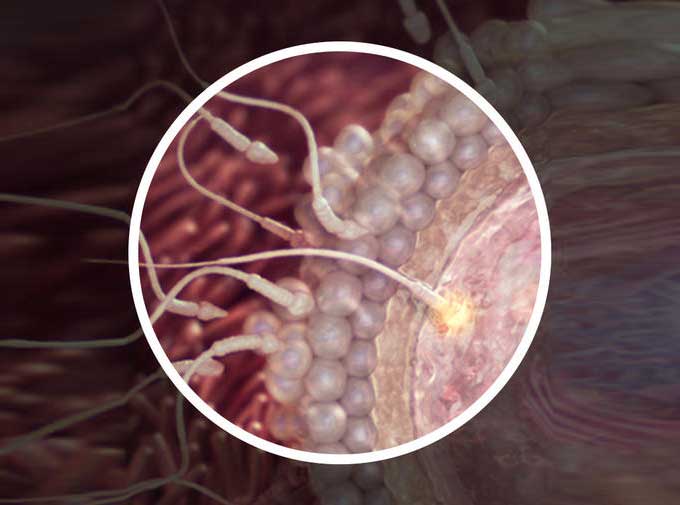
An egg contains an X chromosome, and sperm carries either an X or a Y chromosome. These chromosomes combine to form a zygote and thus fertilization occurs. The egg will be purple in color 24 hours after fertilization. A thick yellow layer forms around it, dense and impenetrable.
ALSO INTERESTING TO READ: Treatment of colds in early pregnancy
Sports in the early stages
Everyone knows that exercise is good for you, but during pregnancy everything changes a little. Women who are accustomed to leading an active lifestyle strive to maintain physical activity throughout the entire period of bearing a baby. This issue should be approached with all responsibility. This will help you get the maximum benefit from physical education and not harm your child.

Prohibited sports:
- exercises involving somersaults, somersaults, turns;
- strength training with weight lifting;
- high-intensity aerobics and fitness;
- horseback riding;
- skiing;
- ice skating (the last two are associated with a high risk of falls).
Recommended types of training:
- dancing;
- aerobics;
- Pilates;
- yoga;
- swimming;
- race walking;
- shaping.
Any sport during pregnancy can be practiced only with the permission of the leading doctor.
Nutritional Features
Due to changes in taste preferences, many pregnant girls find it quite difficult to give up certain foods. Some indulge in sweets, which leads to rapid weight gain, others cannot resist spicy, salty, smoked, sour, and so on. During pregnancy, you should remember that you can eat everything, but a little at a time.
Recommended Products:
- vegetables and fruits;
- greens, salads;
- dairy and fermented milk products;
- porridges, baked goods made from dark flour varieties;
- omelettes, steamed casseroles;
- fatty fish (since this product is saturated with omega fatty acids);
- eggs;
- chicken, rabbit, turkey, turkey meat.
You should limit yourself to the following products:
- fatty pork and beef;
- baked goods, chocolate;
- fast food;
- alcoholic and carbonated drinks;
- It is not recommended to drink strong tea and coffee;
- sour, salty, smoked foods can be eaten in very small quantities, because these foods often increase the tone of the uterus.
A woman must remember that the products must be of high quality. Vegetables, fruits, meat and other products should not be bought at spontaneous markets. Food must be carefully processed before consumption.

During this period, you should avoid eating raw fish and meat, as these products are often sources of parasites.
Nutrition for the expectant mother

Doctors and nutritionists say that a mother’s nutrition is the key to the health of her unborn child. During pregnancy, a woman's diet, of course, undergoes significant changes. Adjustments are made by raging hormones, early toxicosis and the recommendations of a gynecologist. The most basic rule is that meals should be correct, fractional and timely. It is worth excluding all fast food products, flour and sweets, too fatty and salty. But soups, cereals, vegetables and fruits, and lean meat will be beneficial.
